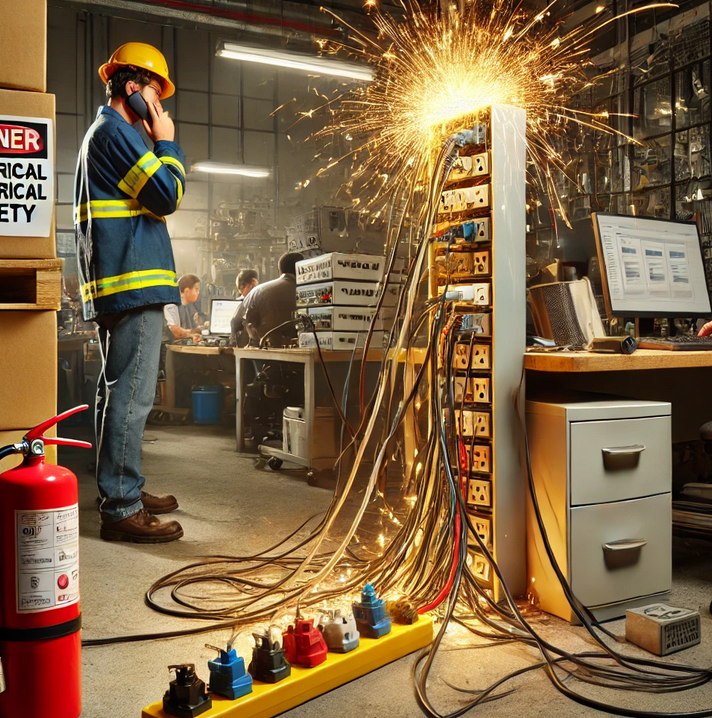Workplace safety is a crucial aspect of any organization, yet many hazards are often overlooked, leading to accidents and injuries. Identifying and addressing these hidden risks is vital to ensure a safe and productive environment.
Here are the top 22 most overlooked workplace hazards and practical steps to mitigate them.
Workplace Hazards
1. Poor Ergonomics
Improper workstation setup can lead to musculoskeletal disorders, chronic pain, and reduced productivity. Desk jobs, factory work, and repetitive tasks often exacerbate these issues.
How to Address It:
- Conduct ergonomic assessments to ensure desks, chairs, and tools are properly adjusted.
- Provide adjustable chairs and monitors.
- Encourage regular breaks and stretching exercises to reduce strain.
2. Cluttered Walkways
Blocked pathways can cause trips, slips, and falls—one of the leading causes of workplace injuries.
How to Address It:
- Implement a clean-as-you-go policy.
- Clearly mark pathways and keep them free from obstructions.
- Conduct regular housekeeping inspections.
3. Inadequate Lighting
Dim or overly bright lighting can lead to eye strain, fatigue, and accidents, especially in areas requiring precision.
How to Address It:
- Assess lighting levels in all work areas.
- Install task lighting for detailed work and motion-activated lights in less-used spaces.
- Replace flickering or damaged lights promptly.

4. Noise Pollution
Excessive noise can lead to hearing loss, stress, and reduced concentration, particularly in industrial or open-office environments.
How to Address It:
- Measure noise levels and provide hearing protection if levels exceed 85 decibels.
- Use soundproofing materials or enclosures for loud equipment.
- Schedule noisy tasks during off-peak hours.
5. Stress and Mental Health Issues
High stress levels can contribute to workplace accidents, absenteeism, and long-term health problems.
How to Address It:
- Promote a culture of open communication and provide mental health resources.
- Offer stress management workshops and access to counseling services.
- Monitor workloads to prevent burnout.
6. Improper Storage of Materials
Improperly stacked or stored materials can fall and cause injuries, particularly in warehouses or stockrooms.
How to Address It:
- Use sturdy shelving and avoid overloading.
- Store heavier items on lower shelves and secure stacks with straps.
- Train employees on safe lifting techniques.
7. Electrical Hazards
Loose wires, overloaded circuits, and unmaintained equipment can lead to shocks, burns, or fires.

How to Address It:
- Conduct regular electrical inspections and maintenance.
- Use surge protectors and avoid daisy-chaining extension cords.
- Educate employees on proper electrical safety protocols.
8. Air Quality Issues
Poor ventilation and exposure to dust, fumes, or chemicals can cause respiratory problems and reduce cognitive performance.
How to Address It:
- Install proper ventilation systems and regularly change filters.
- Monitor indoor air quality and address any concerns promptly.
- Provide PPE such as masks and respirators when working with hazardous substances.
9. Unclear Emergency Procedures
A lack of clear evacuation routes and emergency response plans can result in chaos during incidents like fires or natural disasters.
How to Address It:
- Develop and post clear emergency action plans.
- Conduct regular evacuation drills.
- Train employees on using fire extinguishers and first aid kits.
10. Fatigue
Fatigue, often caused by long hours or irregular shifts, increases the likelihood of accidents and errors.
How to Address It:
- Enforce regular breaks and limit overtime.
- Design shift schedules to ensure adequate rest periods.
- Encourage employees to prioritize sleep and overall health.
11. Unsecured Equipment and Machinery
Improperly secured or maintained equipment can lead to accidents, including entanglements, amputations, or crushing injuries.
How to Address It:
- Use lockout/tagout procedures during maintenance.
- Regularly inspect and maintain machinery to ensure safe operation.
- Train employees on proper equipment use and safety features.
12. Complacency Among Employees
When employees become too comfortable, they may ignore safety protocols, increasing the risk of accidents.
How to Address It:
- Reinforce the importance of safety through regular training and reminders.
- Recognize and reward employees for following safety protocols.
- Address unsafe behaviors immediately.
13. Untrained Temporary or New Workers
New or temporary employees may lack the necessary training to handle specific workplace risks, increasing the likelihood of mistakes.
How to Address It:
- Provide thorough onboarding and safety training for all new hires.
- Assign experienced mentors to guide new employees.
- Monitor their work until they demonstrate full understanding of safety protocols.
14. Chemical Exposure
Improper handling or storage of chemicals can cause burns, respiratory issues, or environmental damage.
How to Address It:
- Ensure all chemicals are labeled and stored according to safety standards.
- Provide safety data sheets (SDS) and train employees on their use.
- Implement spill containment procedures and provide emergency eyewash stations.
15. Workplace Violence
Conflict, harassment, or external threats can create a hostile work environment and lead to physical or psychological harm.

How to Address It:
- Develop a workplace violence prevention program.
- Train employees to recognize and report signs of violence or harassment.
- Implement security measures, such as ID badges and access controls.
16. Lack of First Aid Knowledge
Inadequate first aid knowledge among employees can delay crucial help during emergencies.
How to Address It:
- Provide first aid training and certifications for key staff members.
- Ensure first aid kits are accessible and well-stocked.
- Post emergency contact numbers and protocols in visible areas.
17. Heat Stress or Cold Stress
Extreme temperatures in workplaces like construction sites, foundries, or cold storage facilities can lead to heat exhaustion, hypothermia, or frostbite.
How to Address It:
- Provide adequate hydration and cooling breaks for hot environments.
- Supply insulated clothing and heat sources for cold settings.
- Monitor weather conditions and adjust work schedules accordingly.
18. Overreliance on Technology
Automated systems or safety tech can fail, leading to unmonitored risks or a false sense of security.
How to Address It:
- Conduct regular audits of automated safety systems.
- Train employees to act as a backup for technology failures.
- Emphasize human vigilance alongside technological aids.
19. Lone Workers
Employees working in isolated areas are at greater risk if accidents occur without anyone nearby to assist.
How to Address It:
- Implement lone worker monitoring systems (e.g., GPS trackers or check-in protocols).
- Provide personal alarms or emergency communication devices.
- Schedule regular check-ins during shifts.
20. Shift Work Disorders
Irregular hours or night shifts can disrupt circadian rhythms, leading to fatigue, stress, and long-term health issues.
How to Address It:
- Rotate shifts to avoid prolonged exposure to irregular hours.
- Educate workers about managing sleep and nutrition during shift work.
- Consider implementing wellness programs to address health impacts.
21. Slippery or Damaged Flooring
Unrepaired flooring or spills can lead to slip-and-fall incidents, particularly in wet or greasy work environments.
How to Address It:
- Install slip-resistant flooring or mats in high-risk areas.
- Repair damaged flooring immediately.
- Use “wet floor” signs and clean up spills promptly.
22. Improper Use of Ladders or Step Stools
Falls from improperly used ladders or stools are a common hazard in workplaces like warehouses and offices.
How to Address It:
- Train employees on safe ladder usage, including weight limits and proper placement.
- Inspect ladders regularly for defects.
- Encourage the use of stable equipment instead of makeshift climbing aids.

Overlooking these hazards can have significant consequences for both employees and organizations. Proactively addressing these risks ensures a safer workplace, improves morale, and boosts productivity.
Regular training, inspections, and employee engagement are key to uncovering and mitigating hidden dangers. Remember, safety is an ongoing process that requires commitment at all levels of the organization.
When addressing workplace hazards, it’s crucial to leverage trusted resources for comprehensive insights and actionable solutions. Websites like OHSE.ca provide extensive articles and updates tailored to workplace safety, while organizations such as the Canadian Centre for Occupational Health and Safety (CCOHS) offer guidelines, hazard identification tools, and training programs.
Additionally, the Occupational Safety and Health Administration (OSHA) in the United States maintains an extensive library of regulations and recommendations to mitigate workplace risks.
For industry-specific hazards, platforms like Safeopedia and WorkSafeBC offer tailored safety practices and expert advice.
By exploring these resources, organizations can stay informed about evolving safety standards and ensure compliance with global best practices.

No comments yet